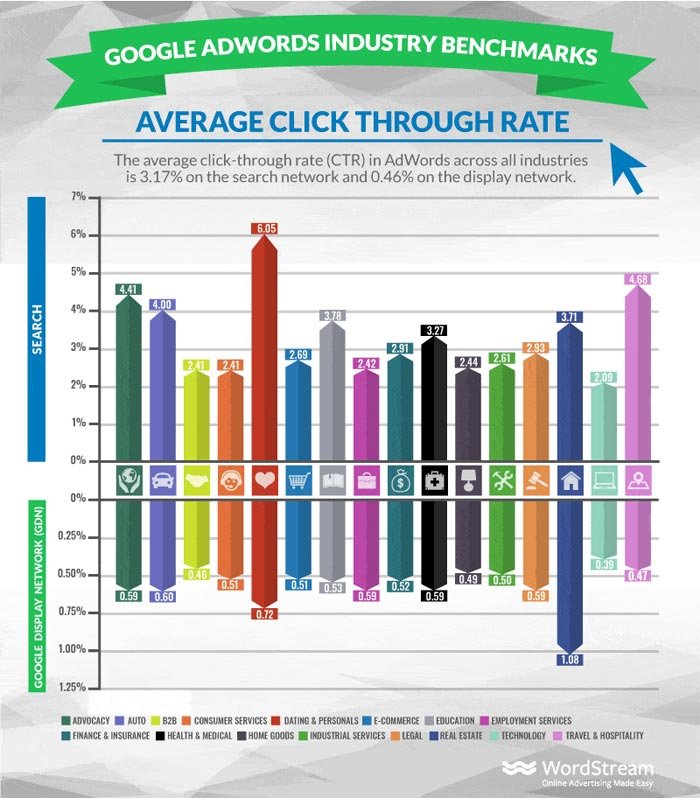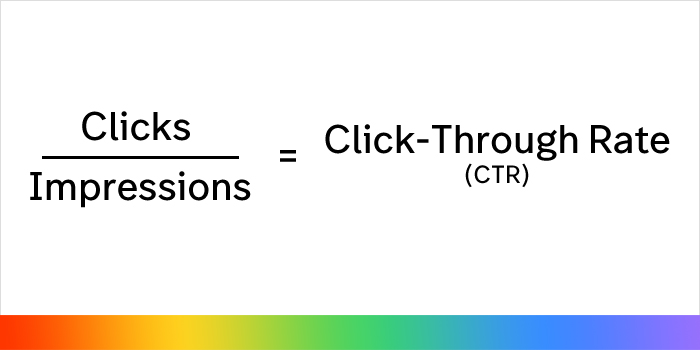


One of the great things about online marketing is that you can measure click-through rate. You can quickly review many types of statistics after you run your marketing campaign. Whether you’re doing pay-per-click (PPC), email marketing, or social media ads, you can review your click through rate daily or even hourly to see your progress.
But what should you expect your click through rate to be, after all your SEO work and online ad efforts? Sources say that the industry average is about 1.9%. However, the rate varies by industry. And for best results, your team should shoot for a higher quality scores click-through rate.
Below, we discuss click through rate overall, industry averages, plus ways you can up your click through rate and achieve better marketing success.
Table of Contents
Toggle
Below are the click-through-rates for some of the biggest online industries (Search Network CTR):
For 16 industries monitored by Google for its ad business, the average click through rate is 3.17%. For the Google Display Network, the 16-industry average is .46%.
What makes an excellent click through rate, then? There is no precise number that we can state for every business. But you want it to be as high as possible! A higher click through rate means more people viewing your product and services, which is always good.
Some marketing experts recommend having a click through rate that is at least as high as your industry average. Aim for a bit higher for best search results page.

Now you understand more about what a good click through rate is for your industry, but how to get there? Keep reading!
If you want to have a massive influence on your click-through rates, focus on keywords and match-type.
Ad copy matters, too, but that doesn’t matter unless the ad appears on a search engine result page (SERP).
If you have advertisements that have many broad match keywords, the odds are high that your copy could appear for irrelevant queries. One of the biggest culprits for broad ad groups is the keyword suggestion tool offered by Google or other search engines.
It can help you see your options, but it’s not recommended to go with their recommended match-types automatically. If you go with their recommendations, make sure to use their key at the bottom so you pick the right match type.
Signals for every match-type are:
It’s essential to practice vigilance if you can describe your product or service in ways that can net trigger queries in other industries.
Let’s say you’re a patent attorney and you love wearing patent leather shoes. But you’re probably not gunning for people viewing shoes to click on your legal ad, right?
You don’t want the word “patent” to be for any match-type – except exact.
Remember to use negative keywords to avoid queries that could come from other match-types and other keyword meanings.
For instance, cat rehabilitation can be interpreted as cat training or taking kitty to the veterinarian. The prices for each of those search results are much different. Depending on your ad budget, you may not want to use those terms that could trigger unrelated results and money down the drain.
Note that keywords that are in your advertisement groups need to be very likely to produce good queries.
If you have a shot that a long-tail keyword of 3 or more words is better, use it. However, if your specific niche has a lower search volume, you may want to choose a broad concept, as long as you have a long negative list.
Advertisement copy isn’t just a tired formulaic blurb anymore. Now we have three headlines, a couple of descriptions, and a growing list of extensions to entice our prospects to contact us.
But it’s easy to fall back into old habits and use copy backed by ‘data,’ and not take full advantage of the tools at our digital fingertips.
When humans craft your ads, you have a higher click through ratewhen the ad includes an H3 and D2 – about 8%. When there is no H3 and no D2, the click through rate falls to about 5%.
Mobile devices usually only give two headlines but usually do list both descriptions. Also, using the description provides the ad with more beef. The larger ad usually produces a better click through rate.
Also, note that ads that have all descriptions in headlines get a high CTR, studies show. So, please use them.

You’d be surprised to learn how many suitable ads lack a strong CTA or call-to-action. If your advertisement doesn’t have a strong CTA, you’re tossing your money away. Remember to use one of these:
The purpose of paying for paid search ad is to get prospects to act – go to your website. Some experienced hands say CTAs work great in H2. Others like to lead the ad with the CTA. You can test both in your industry and see which produces.
Note that having repetitive language in your ad will ding your Click through rate. For example, using a single word three times or more in an ad generally lowers engagement.
Who is seeing your online advertising, where and on which device are big deals for a high Click through rate. If you’re going after more than one region, remember that people around the country think and search differently.
Putting every region in your country makes the ppc account easy to manage, but it could hurt/effect click through rate(CTR).
Google lets you make the target location a choice in an ad campaign, so you could need to limit the first campaign to one or two markets. When you have hard data on which ad works best, you may expand to more markets, change up the ads and keywords per the local search methods.
All it can take is to alter your ad’s copy to ‘request a call back’ after hours. It shows you’re a human thinking about the person reading the ad.
Now you should know more about the ideal/good CTR and how to boost yours. We can help you with our PPC management services, including help with your suspended Google Ads account. Contact us today!
Please fill the below form to download the PDF
“*” indicates required fields.
Please fill the below form to download the PDF
“*” indicates required fields.
Please fill the below form to download the PDF
“*” indicates required fields.
Please fill the below form to download the PDF
“*” indicates required fields.
Please fill the below form to download the PDF
“*” indicates required fields.
Please fill the below form to download the PDF
“*” indicates required fields.